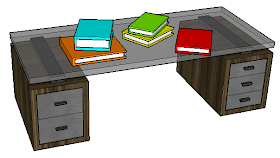This is a good month if you like cliffhangers - two of the projects are Part 1 (of 2). If you're a subscriber to our
Projects of the Month, here's what will arrive in your Inbox on February 15:
Piano KeysPart 1 of this project goes out in February, and shows how to create one octave of piano keys, based on actual dimensions of a grand piano.

Part 2, which will go out in March, shows how to use the black keys (OK, they're yellow in my example) to make the cutouts in the white keys.


Components and ColorsThis project shows a good use of components: to create a random look for multiple, similar objects. The example involves a set of books. Rather than create each book separately (which would load of SketchUp with extra objects) you only need one.

When the book is a component, it's easy to make a bunch of them in different sizes and shapes, and to apply different colors to the covers.
 Fibonacci Spiral
Fibonacci Spiral
Many patterns in nature are based on Fibonacci numbers. This project (Part 1) starts off by creating the famous Fibonacci spiral.

In Part 2, which will go out next month, you'll take one spiral and rotate-copy it so that a flower forms.


As always, the yearly subscription is just $36 for the year - that's 36 projects for just $1 each!
Subscribe here.Anyone can design anything in 3D! http://www.3dvinci.net/









